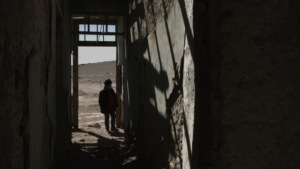By Francisco Rivera, Research Associate, The Archaeology Centre, University of Toronto, Canada
Mrs. C.A. stands at the threshold of the Borlando house – a place that was once off-limits to her – waiting for us to take a photo and capture a moment in time. This house was the property of the owners of Buenaventura, a sulfur mining camp nestled in the Ollagüe municipality on the international border between Chile and Bolivia. Sulfur mining in Ollagüe thrived from 1916 to the early 1990s, and today, the place is a testament to its past, with ruins scattered across the arid, high-altitude landscape. Mrs. C.A. spent her childhood in this camp, and on a bright November day a few years back, we revisited it together. What was life like there? What memories does she hold of the camp’s closure? How does she perceive the ruins today? As a Quechua woman, what does being a Chilean citizen with family ties to the Bolivian side of the border mean? What has changed since Buenaventura ceased its operations?
These questions, among others, have been examined through the DePOT-affiliated Alto Cielo Archaeological Project. Since 2015, researchers from different backgrounds (historical archaeology, anthropology, architecture, and social history) have been working on several abandoned mining camps in the area, such as Buenaventura. The project focuses on labor and working conditions, as it sheds light on the workers’ experiences in these industrial settings. Migration, ethnic identity, gender, nation, ecological impacts, and heritage have also been critical areas of investigation. While at the beginning of the project, the main objective was to document the years of industrial development, interviews have forced us to shift our focus. The last years of operations and the consequences of the camp closure were omnipresent in every conversation and have pushed us to examine this period.
In Ollagüe, sulfur mines closed one after the other from the 1980s until 1993 as a consequence of what Jaime Gatica (1989) called the ‘monetarist experiment’ under Pinochet’s Chilean dictatorship. Mining was carried out in this Indigenous territory, where most of the workers of the industrial adventure were local inhabitants working under a kind of semi-proletarian condition. One of the issues that arose during interviews and informal conversations is how people of the communities never returned to their former agropastoral lives after Ollagüe’s mining closures but migrated to other contemporary industrial mines in the region. Places were abandoned, but people remained ‘miners.’
A few kilometers before arriving in Ollagüe, you will see signs with information about the local history. A subtle form of State territorialization in Indigenous land, signs such as the one that reads ‘The Desert Route. Desert and Archaeology’, aim to remind the traveler of the region’s history, as seen in the ruins of the Buenaventura mining camp. Moreover, amid the ruins, but in places visible from the road that connects the camp to the highway, you will also see some decrepit political propaganda posters. Placing a candidacy advertisement on an abandoned site in the desert might seem like a lousy advertising strategy. But the truth is that the site has connotations beyond abandonment. It continues to be visited every year: curious tourists or passers-by, former residents searching for building materials, or simply visiting the crumbling old houses they once occupied. This ongoing connection to the ruins, this continued interest and interaction, underscores their enduring significance. Road signs and political propaganda are ‘texts’ that contribute to remembering the long-gone past of privately owned industrial developments. Furthermore, they are markers of the Chilean State’s presence in Indigenous lands, a presence that is constantly being materially renegotiated and reinterpreted. Arjun Appadurai (1986) taught us years ago about ‘the social life of things,’ the notion that objects have a life beyond their moments of production and use, a crucial concept in understanding the role of material culture in shaping human experiences. In Ollagüe, sites and artifacts of the recent industrial past function similarly. Their life exceeds their abandonment, and what is essential is less their origin than their social life in the present, in their complex relationships with deindustrialized contexts.
During our visit with Mrs. C.A., we walked together through Buenaventura, and she shared moments of her life in this once-striving place. We also shared silences, moments in which she walked alone, looking for things and memories we would never understand, her lived experiences that, unlike road signs, cannot be transposed into words. We followed her at a distance, observing her movements, cadence, and rhythms while walking among the camp’s rusty machines and rubble. At the end of the afternoon, we gathered at a tomb located next to the owner’s house. This recently added white-colored tomb with simple decoration and paper flowers is that of Buenaventura’s last inhabitant, who chose the camp as his final resting place. By thinking about how the tomb testifies to this emotional bond with the place and how death acts as a statement of appropriation for eternity, I realized the challenges of the deindustrialization narratives. How can we tell these stories without transforming them into another form of tamed intangible heritage and textual appropriation? How do we limit the weight of the “nation” in the face of local experiences? In a position of self-reflexivity, I am thinking about the authorized claims of what is worth remembering while avoiding having the industrial heritage of the Indigenous peoples of Ollagüe transformed into a nostalgic souvenir to create a false spectacle. Much like the road signs or the propaganda posters, this would be nothing more than another State and colonial form of cultural appropriation.
These questions bring forth a more extended discussion about colonial narratives, textuality, positionality, and the complex relationship between Indigenous people and the imposed narratives of the Nation-State. In Chile, the ideological foundations of the ‘imaginary nation’ (Anderson, 2006) were reinforced by the end of the nineteenth century with the territorial expansion of the Chilean state after the Saltpeter War (1879-1884). This expansion reshaped the national imaginary and policies surrounding the integration of local – and mainly Indigenous – populations, a process known as ‘Chileanization.’ This moment marked a turning point in the administrative and symbolic incorporation of the region’s indigenous peoples within the Chilean state. The construction of the idea of nationhood thus took the form of national narratives. These narratives aimed to articulate a past that indicated the nation’s superiority, breaking with previous periods and rejecting anything that escaped the principles of cultural homogeneity and progress. The pejorative category of ‘Indian’ ceased to be considered as a stigma of ‘foreigner’ and was incorporated under the category of ‘ethnic minority.’
In Ollagüe, the ‘Indian,’ which had previously been defined ambiguously, ceased to represent a cultural or economic category differentiated from the rest of society and became part of a new political paradigm in the modern sense: the citizen. While the mining companies created the ‘miner subject,’ disciplined and controlled, the state created the ‘citizen subject,’ a member of the culturally homogeneous Nation. Following José Luis Martínez (2011), when colonial authorities named Indigenous groups (e.g., Quechua, Aymara), they constituted and fixed a set of identities. Researching the impacts of deindustrialization reveals a similar process when describing ‘miners’ or ‘settlers.’ According to Martínez, multiple actors emerge through naming, which implies at least two operations. The first is to identify; by this, Martínez means distinguishing, differentiating, or setting limits. The second is to fix a name to its bearer, whether it is a collective subject (the Chilean Nation) or a singular individual (Mrs. C.A.), producing a union intended to be permanent.
Before leaving, I asked Mrs. C.A. if the camp owners could have tried harder to keep it running for a few more years. Maybe they could, she said, but who knows? Some people believe – she told me – that the sulfur was exhausted or that the volcano itself decided it no longer wanted to provide its minerals. As we walked back to the town, I thought she was right. Like the tomb or the political propaganda posters, particular objects and other non-human agents such as sulfur and volcanoes, also stand under the threshold, waiting for us to incorporate them into our narratives. They invite us to delve into more inclusive and complex narratives about the impacts of mining closures and deindustrialization.
References
Anderson, B. (2006). Imagined Communities. Reflections on the Origin and Spread of Nationalism. London: Verso.
Appadurai, A. (1986). Introduction: Commodities and the Politics of Value. In A. Appadurai (Ed.), The Social Life of Things. Commodities in Cultural Perspective (pp. 3-63). Cambridge: Cambridge University Press.
Gatica, J. (1989). Deindustrialization in Chile. Boulder: Westview Press.
Martínez, J. L. (2011). Gente de la tierra de guerra. Los Lipes en las tradiciones andinas y el imaginario colonial. Lima and Santiago: Fondo Editorial de la Pontificia Universidad Católica del Perú, Dirección de Bibliotecas, Archivos y Museos de Chile.





